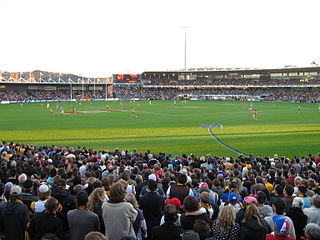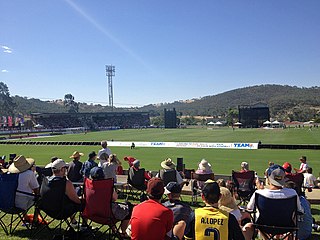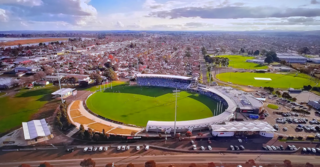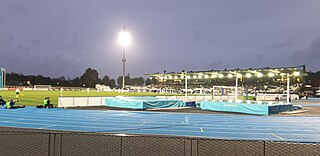
There are many forms of transport in Australia. Australia is highly dependent on road transport. There are more than 300 airports with paved runways. Passenger rail transport includes widespread commuter networks in the major capital cities with more limited intercity and interstate networks. The Australian mining sector is reliant upon rail to transport its product to Australia's ports for export.

Launceston Airport is a regional airport on the outskirts of Launceston, Tasmania. The airport is located in the industrial area of Western Junction 15 km (9.3 mi) from Launceston city centre. It is Tasmania's second busiest after Hobart Airport; it can also run as a curfew free airport.

York Park is a sports ground in the Inveresk and York Park Precinct, Launceston, Australia. Holding 19,500 people, York Park is known commercially as University of Tasmania (UTAS) Stadium and was formerly known as Aurora Stadium under a previous naming rights agreement signed with Aurora Energy in 2004. Primarily used for Australian rules football, its record attendance of 20,971 was set in June 2006, when Hawthorn Football Club played Richmond Football Club in an Australian Football League (AFL) match.
Australians generally assumed in the 1850s that railways would be built by the private sector. Private companies built railways in the then colonies of Victoria, opened in 1854, and New South Wales, where the company was taken over by the government before completion in 1855, due to bankruptcy. South Australia's railways were government owned from the beginning, including a horse-drawn line opened in 1854 and a steam-powered line opened in 1856. In Victoria, the private railways were soon found not to be financially viable, and existing rail networks and their expansion were taken over by the colony. Government ownership also enabled railways to be built to promote development, even if not apparently viable in strictly financial terms. The railway systems spread from the colonial capitals, except for a few lines that hauled commodities to a rural port.
QantasLink is a full-service, regional brand of Australian flag carrier Qantas and is an affiliate member of the Oneworld airline alliance. As of 2024, QantasLink provides over 2,000 flights each week to over 50 metropolitan and regional destinations across Australia, as well as short-haul international services to New Zealand, Singapore, the Solomon Islands and East Timor.
Air traffic control in Australia is provided by two independent organisations, one civilian and one military. The civilian provider is Airservices Australia, which controls civilian airfields and airspace. The military provider is the Royal Australian Air Force (RAAF), which controls military airfields and adjoining airspace. This includes Australian Army and Royal Australian Navy aviation bases.

Lavington Sports Ground is a sports ground located in the suburb of Hamilton Valley near Lavington on the north-west fringe of the city of Albury, Australia. The oval is nestled in the side of a hill, with concrete terraces cut into the southern side of the oval below a grass embankment and the grandstand and changing rooms located on the north-west flank. The venue also incorporates a 4 table cricket wicket, a velodrome for track cycling and two netball courts. The Lavington Panthers Sports Club licensed club was formerly located next to the ground, across Hanna Street.
Sport in Tasmania is participation in and attendance at organised sports events in the state of Tasmania in Australia.

The earliest trams in Australia operated in the latter decades of the 19th century, hauled by horses or "steam tram motors". At the turn of the 20th century, propulsion almost universally turned to electrification, although cable trams lingered in Melbourne. In cities and towns that had trams, they were a major part of public transport assets.

The John Holland Group is an infrastructure, building, rail and transport business operating in Australia and New Zealand. Headquartered in Melbourne, it is a subsidiary of China Communications Construction.
The history of the Tasmanian AFL bid covers a series of proposals and bids between 1987 and 2023 for a Tasmanian-based Australian rules football team in the Australian Football League and AFL Women's premierships. Eight formal proposals for a new or relocated club to represent Tasmania were made over this time, the earliest coming in 1992, while informal proposals were raised as early as 1987, when the Victorian Football League commenced its expansion to become a national competition.

Eureka Stadium, known commercially as Mars Stadium, is an oval-shaped sports stadium located in the Eureka Sports Precinct of Wendouree, 2.9 km (1.8 mi) north of the CBD of the city of Ballarat, Victoria, Australia.

Lakeside Stadium is an Australian sports arena in the South Melbourne suburb of Albert Park. Comprising an athletics track and soccer stadium, it currently serves as the home ground and administrative base for association football club South Melbourne FC, Athletics Victoria, Athletics Australia, Victorian Institute of Sport and Australian Little Athletics.
Glen Eira Sports and Aquatic Centre (GESAC) is an aquatic centre that was developed by Hansen Yuncken and is owned by City of Glen Eira. It is a rival to Melbourne Sports and Aquatic Centre as it contains a 50-metre outdoor pool, 25 metre indoor pool, water slides, leisure pools, gymnasium and a stadium. It was constructed at a total cost of $44m dollars, with significant contributions from Federal and Victorian State Governments.

The Queensland State Netball Centre, also known commercially as Nissan Arena, is a multi-purpose facility located in the southern Brisbane suburb of Nathan. The centre features a 5,000 seat indoor arena that is the home court of Super Netball team the Queensland Firebirds, as well as National Basketball League club the Brisbane Bullets. It is the administrative headquarters of Netball Queensland and provides training facilities for elite-level and community-based netball clubs in Queensland.
The 2019 FFA Cup was the sixth season of the FFA Cup, the main national soccer knockout cup competition in Australia. 32 teams contested the competition proper, including 10 of the 11 A-League teams and 21 Football Federation Australia (FFA) member federation teams determined through individual state qualifying rounds, as well as the reigning National Premier Leagues Champion.











